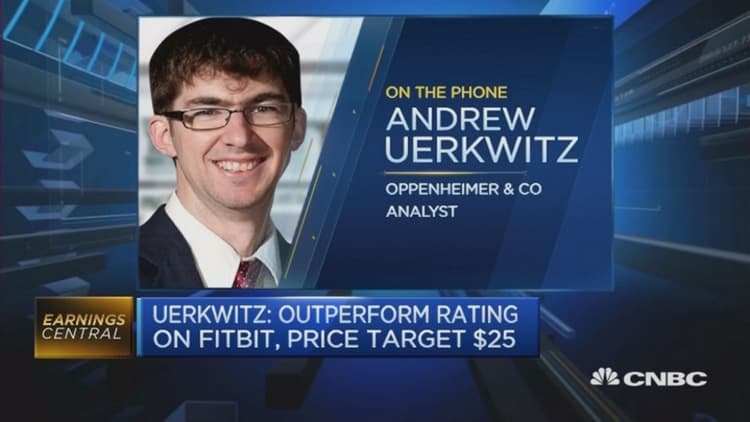WiseWear is on a mission to make aging cooler — by offering fashionable, gadget-friendly wearables for seniors. It's a lucrative niche that offers huge potential.
The $20 billion wearable market, which is now mostly basic activity trackers, is exploding and will grow 44 percent this year alone. And sales are expected to reach $70 billion by 2025, according to IDTechEx. Considering the aging population, which drives the $7 trillion longevity market of 50-plus consumers, the senior market offers huge potential.
Yet surprisingly, aesthetics is a top priority. Demand is growing for innovative, high-fashion jewelry, wristwatches and other wearables that can send alerts and notify emergency contacts with your GPS location and can track hydration, along with other functions, such as measuring glucose levels and blood pressure.
And who better to partner with WiseWear to design the new line of luxury smart bracelets than the 94-year-old flamboyant fashion icon Iris Apfel, known for her mountains of bangles and saucer-size black eyeglasses.
"These wearables are sorely needed by seniors," said Apfel. "Many people have falls, and some of them are fatal." And as she pointed out, technology doesn't have to look ugly.
People run away from large devices with red buttons, such as medical alert devices, that scream, 'Old person walking,' said Joseph Coughlin, director of the AgeLab at the Massachusetts Institute of Technology. "But what about wearables that are functional, fun and fashionable?" he adds. "They will gain traction. Very few people see themselves as old and frail." These wearables will be blending into our bodies almost invisibly through clothing or materials. Coughlin calls this phenomenon "functionality by stealth."
As our society gets grayer, more people will want to age in place, say many experts. And they're the targets for wearables, which can help people stay healthier longer.
The WiseWear smart jewelry line, called the Socialite Collection, includes three different brass smart bracelets and come plated in your choice of 18-carat gold or palladium and range in price from $295 to $345. If you didn't know it was a connected bracelet that can track activities and send distress alerts, you'd think it was a fashion accessory.
That's no surprise. The multimillion-dollar businesswoman and designer, who was recently celebrated in Albert Maysles' latest film, "Iris," has been shaking up the fashion industry since she and her husband opened a textile business in 1950. Throughout her career, she's been a trailblazer — spearheading a White House restoration project for the Kennedys and developing a collection of accessories, fabrics and garments that were so eye-catching they were exhibited at the Costume Institute at the Metropolitan Museum of Art.
Wearables that are functional, fun and fashionable ... will gain traction. Very few people see themselves as old and frail.Joseph Coughlindirector of the AgeLab at the Massachusetts Institute of Technology
WiseWear founder and CEO Gerald Wilmink claims the line of senior wearables is a personal mission. When his grandfather slipped and broke his hip while climbing stairs in his home in 2010, he wasn't able to call his wife. Wilmink doesn't want that to happen to other elders.
"We wanted to lose the screen and not the moment," said Wilmink, who is bringing out more wearables at year-end. "Another screen takes away from human interactions."
Lots of other so-called stealth devices are gaining notice, too.
Hearables, like Eargo, which are reenvisioned hearing aids that are so small they float invisibly inside the ear, are targeting hearing loss, which plagues half of all baby boomers. The global hearing-aid market is estimated to be about $6.2 billion. This device starts at $1,980. "Hearables are cool and smart and help people navigate," said Stephen Johnston, a co-founder of the technology accelerator Aging 2.0. "And hearing is a big topic."
The health and fitness wearable B60, made by Nobo, which was originally invented for athletes, measures hydration levels that can be relayed to an app. It will be available in mid-2016. Ringly, which is a gold smart bracelet made of lapis, moonstone and other gemstones, lights up and buzzes when a message is relayed to a smartphone. It will be on the market later this summer and sells for $195.
"The good ones integrate wearable computing into jewelry," said Coughlin, "so that it's functionality by stealth."
Smartwatches, like the slick Lively Safety watch that was just acquired by GreatCall, is embedded with sensors and can also send emergency alerts and issue medication reminders.
Jean Anne Booth, CEO of UnaliWear, is also out to shake up wearables. A serial entrepreneur, Booth was drawn to wearables when her elderly mother didn't want to wear an alert button. So Booth got the idea to create a wearable watch that's voice activated and doesn't need a smartphone. The wearable, expected to be on the market this summer, also sends distress signals, location assistance and other alerts. She calls it OnStar for seniors.
"I wanted my mother to live independently," Booth said. "Why give control to someone else?"

The over-65 market is growing, explained Shailendra Mahajan, managing director of Maxim Ventures in San Jose, California. "People in that age group will be monitoring vital signs," said Mahajan, who invested $1 million in UnaliWear. "They want a good quality of life."
Yet wearables are still in their infancy, say experts. The companies are currently too small to shake the market, so predicting market winners can be tough. And, too, lots of data collected by wearables isn't being analyzed, they say.
"We're getting data from everywhere," added Coughlin, "and not enough information to act on." He calls this data collection the quantified self. "So a smartwatch may not make me smarter," he said. "Behavior change is emotional rather than one more byte of information."
Anyway, wearables will be a fast-passing trend, Coughlin said. They'll eventually be replaced by implantable technology or sensors embedded in clothing and materials. The objective, he added, is blending into user lifestyles.
"Even so, wearables and related services will help make aging cool," he concluded.
— By Constance Gustke, special to CNBC.com


